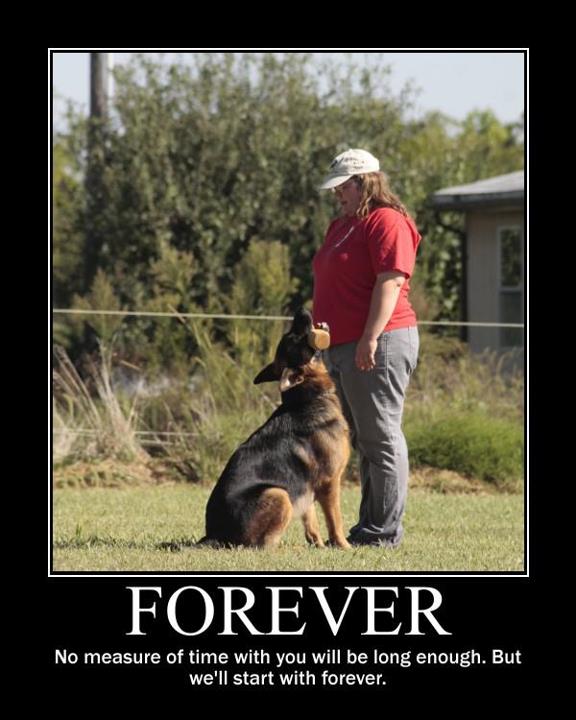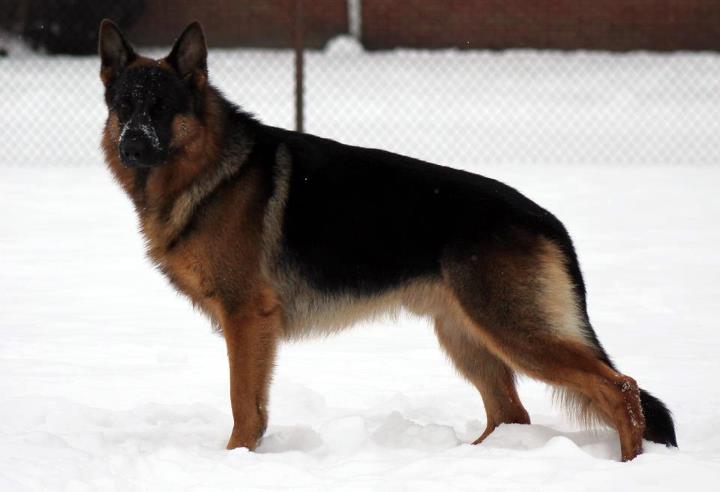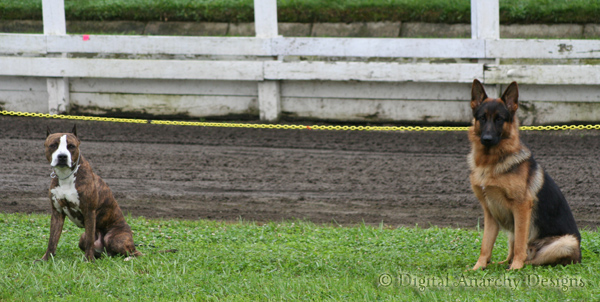Another wonderful blog entry by Jen Rainey of Vom Haus Huro.
——————————————–
Masochists? Really? Well, the definition of masochism, is the condition in which gratification depends on one’s suffering physical pain or humiliation. Switch that to pain AND humiliation and it would fit like a glove (or like a crisp new Schweikert trial arm). It is easy to torture oneself with trying for the perfect obedience round. It is all good fun to try for that better tracking score. It is absolutely a good time to train your dog to go after a guy dressed in an almost spot on Stay-Puffed Marshmallow Man get up. Sure, it all makes perfect sense. Do any one of those things and have fun. Do all three together? Welcome to my insanity. Welcome to my addiction. Welcome to my sport.
Schutzhund was developed and molded to be the triathlon of the dog world. 3 events, one dog, one handler, one day. What it has evolved into is a highly specialized sport requiring almost Herculean effort and extreme dedication (much to the dismay of close friends and relatives). Tracking. Obedience. Protection. They bill it as the T.O.P. Dog sport. They lure you in with training vests, tracking lines, balls on a string and new jute covers for that shiny new sleeve that you will convince yourself you and your dog cannot live without. Then there is the fourth aspect of the sport, the one that you will hear loudly and proudly discussed in the clubhouse, but hushed in the presence of the “newbs”: the handler injury. If you want to play protection dog, you’re going to have to be willing to bleed.
At this point it sounds scary, doesn’t it? Trust me, it’s not so bad. You will learn to love it. The virus will slowly take over your system and you will find yourself smiling in delight at that perfect 6 a.m. track, as opposed to groaning in indignation at your own stupidity for actually discovering that your alarm clock does, in fact, contain a 4 a.m. and yes, that shrieking alarm does expect you to wake up to “such it up”. Watching your dog at the end of a 33 foot line come up to, and indicate, an article will be the most satisfying experience you have had since graduation. The perfect turn that is taken on a track leg will fill you with the same pride as looking down at a quickly and correctly completed Rubiks cube. Whether you are trying for your IPO1 title and you lay your own 450 yard track with 2 turns, slightly aged and your own articles or you are trying for the elite IPO3 with its 800 yard length, laid by a stranger and aged 45 minutes just to make you queasy, the happiness you experience from a passing score will be the same. Precision, pride, tranquility. Tracking. One phase down. If you were lucky enough to score 70 points or more out of the possible 100, take those field boots off and strap on your sneakers. Time for obedience.
Schutzhund obedience is one of the fastest paced and exciting things out there. Fast? Exciting? Obedience? I kid you not. Extreme drive and the ability to cap it are essential in obedience. The build up of drive and then stopping it and compressing it becomes an art form. Eventually that build up has to explode. By design, that is inevitable. By training and luck, that explosion becomes crisp, correct and joyful obedience. The sheer joy of having your dog at your side, completely amped up and yet focused on you and remaining compliant and biddable is absolutely unequaled. The multitude of times that your dog had missed the ball and gotten your thumb will be forgotten. Those flesh wounds from doing targeting practice with tug toys that the manufacturers seem inclined to make smaller and smaller are now scars worn with pride and a sense of contentment through accomplishment. A mere 300 paces stands between you an accomplishment. Well, 300 paces, 3 retrieves, motion exercises (sit and down while moving for the IPO1 with a stand from motion and extra recalls added in for the IPO2 and 3) and then the send out. Why split hairs, though. Energy. Compliance. Intelligence. Obedience. A mere 70 points out of 100 once again stands between you and the next phase. Let’s do this.
Protection is in many ways just a continuation of obedience and yet it is the most popular of all the phases in terms of spectators. Maybe because they don’t have to get up at 6 a.m. like you do for tracking. Maybe because not every dog guards the same, but if you have seen one dog do the flat, meter jump and wall retrieves, you’ve seen them all. Or maybe its simply the display of raw power harnessed by the power of a bond with a human utilizing voice. Oh yeah, and the dogs bite stuff. Who doesn’t want to see someone get bit at the end of any day. That’s just good fun. Between the handler and the helper man (who I surly hope has good insurance) stands between 2 and 6 blinds. The dogs have to learn to search the blinds at the direction of their handler in order to show their obedience and their commitment to the search process for locating our bad guy. Now the real fun begins. I know the helper is in the last blind. The dog knows he is in the last blind. The crowd has helpfully pointed that fact out to both the dog and I with their clustered presence in that area in case either of us were too dim to figure it out or too nervous to remember. Target acquired. Missile locked and loaded. Time for blind searches.
Now you need to send your dog, who is almost out of their mind with anticipation, to a blind in the opposite direction of where Senor Bad Guy is camped out. Your dog will look at you like you are crazy and then, if you are lucky, with acceptance, as they race away from their target and around the empty blind. Requirement met. Game on. As your dog races back toward you, you get the extreme pleasure of shouting to your dog “HERE…REVIERE”. This is a two point process. You will see your dog look at you when you yell “Here” with an expression that clearly says “Really? He’s like, right there” but when you get that eye contact and you extend your arm toward the hot blind and say “reviere” you are rewarded by a brief flash of excitement in your canine teammates eyes as they double their speed and race toward that blind and bad guy saying “oh yes, I’ve got this”. Here comes my dog, helper man. Hope you are ready to fight.
Now as your dog disappears behind the blind you hold your breath. One of two things will now happen. Either the excitement will make your dog deranged with its own power and he’s going to go in for a bite or training will have won over and you will hear the sweet sounds of a machine gun bark, complete with ample flashing of all 42 teeth as your dog unleashes a full set of colorful doggy expletives at our decoy buddy in the blind. Once the barking starts, so does the fun The judge now signals you over for the pick up. You watch, awed despite yourself, as your dog ignores your approach in favor of making sure that his suspect stays put. You approach about six feet behind and the moment of truth you have been dreading arrives. “Hier…fuss”. You are asking your dog to leave his guard and return to a heel position. It is time to move this suspect. Come on out dirt bag, we got you.
You try and fool your dog into believing you are in control by ordering the helper around in your best, tough guy voice. Considerably harder when, like myself, you are a girl with a fairly non serious personality. I suggest watching some Law and Order to prepare. It couldn’t hurt. “Helper, STEP OUT”. Now you hope that when the helper steps oput and moves around the blind your dog will stay in heel position. Thankfully, he does. What a good boy. Time for the escape bite. You leave your dog to guard the bad guy while you retreat behind the blind. Bad guy now makes a bad decision and attempts to escape. Kill. Maim. Destroy. It’s escape bite time. Poor guy usually doesn’t get further than a few feet before gaining a weighty attachment to their left arm. A quick out command, followed by the dog releasing shows that you are still in control. Now the bad guy threatens again, the dog counters and the drive begins. During the drive the dog is threatened by the helpers physical proximity and a padded stick for extra emphasis. A leather wand and a little hug? Threaten my dog? Please. He eats my hands for obedience. He knows no fear.
Now after we out our dog from the drive we come to what, for me, is the best part of the day. Courage test time. Now we take our dog WAY down to the very end of the field and face our helper who is at the opposite end. A field apart we square off. It is now the helpers job to show us just how scary he can be. He is going to come at us with everything he has. Yelling, waving his arms and physical presence are being used to imply that he would like to rip me apart…..and my little dog too. Moment of truth time. All the training in the world wont give a dog the nerves to stand up to that sort of threat. That comes from genetics and a lot of luck. Hold that collar. Breathe deeply. Send your dog.
What follows next is beautiful. Helper and dog each hurling toward each other with everything they have. You watch your dog pick up speed, target the sleeve and then launch. A mere few seconds later they are back on the ground and into another fast drive, just to make sure the dog meant that long bite. End of drive. Helper gives up. Out your dog. Now you move in. You pick up your dog in a heel and you move around to disarm the helper by taking the stick. With your ever vigilant dog by your side between the two of you, you move to the judge. Then the words that seal the entire deal. “Jen and Digger. Reporting out for IPO2 protection.” 70 or above and you are now that new shiny title. 80 or above and you get that title and the chance and privilege to attempt the next highest level at the next trial. Hostile. Agile. Mobile. This is protection.
The next week when your 4 a.m. alarm blares, you reach over and turn it off, grab your band-aids and your hot dog slices and head out into the pre-dawn darkness. Why? Because the virus is no longer controlling you. You are now the virus. The only treatment is more training, the only goal the next title. This is schutzhund. Schutzhund is life.
If all goes well you can go to an World level competition and when you are done. It’s time to start the next dog. After all, every addict needs their fix.





